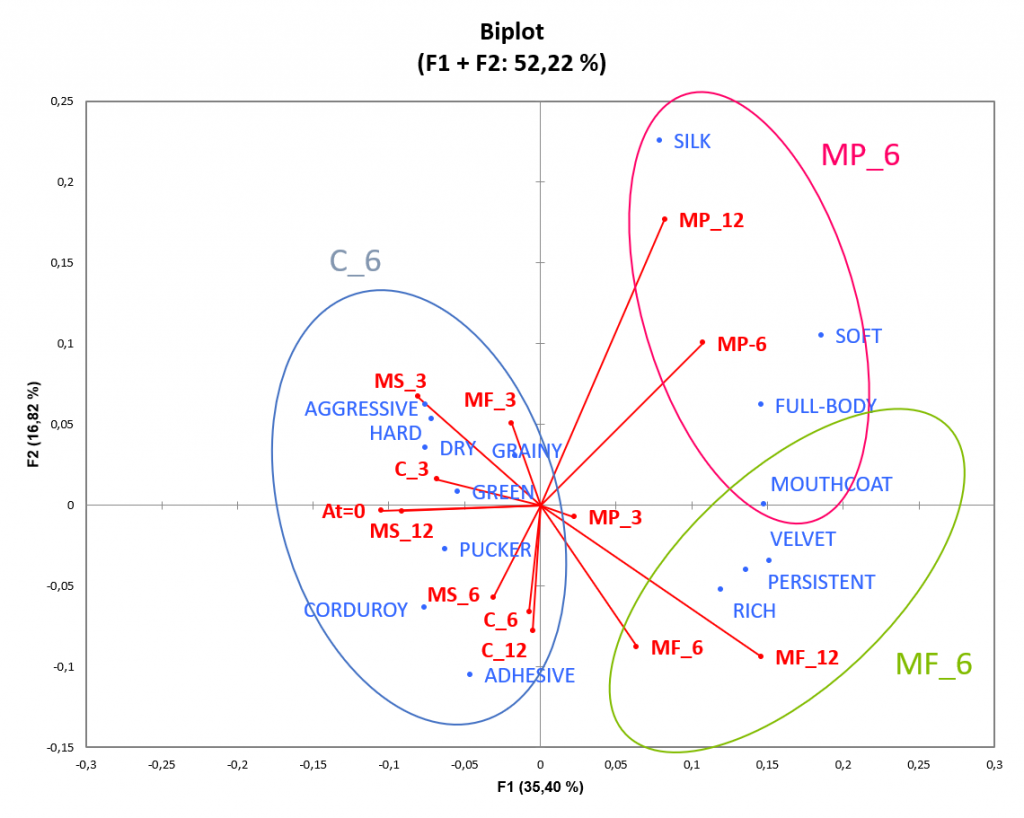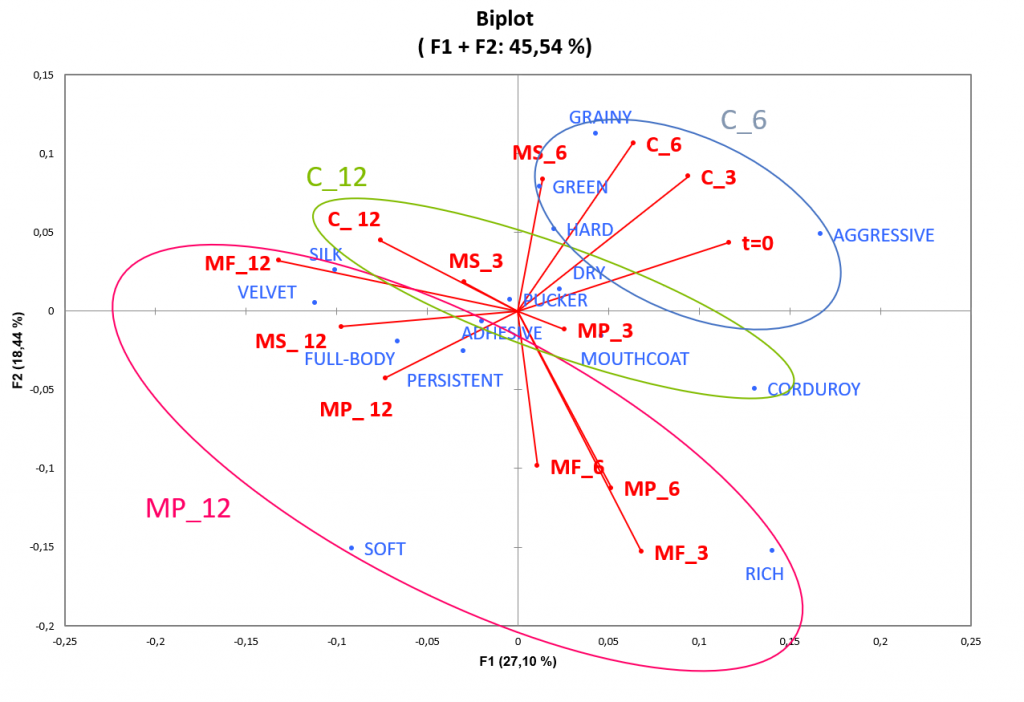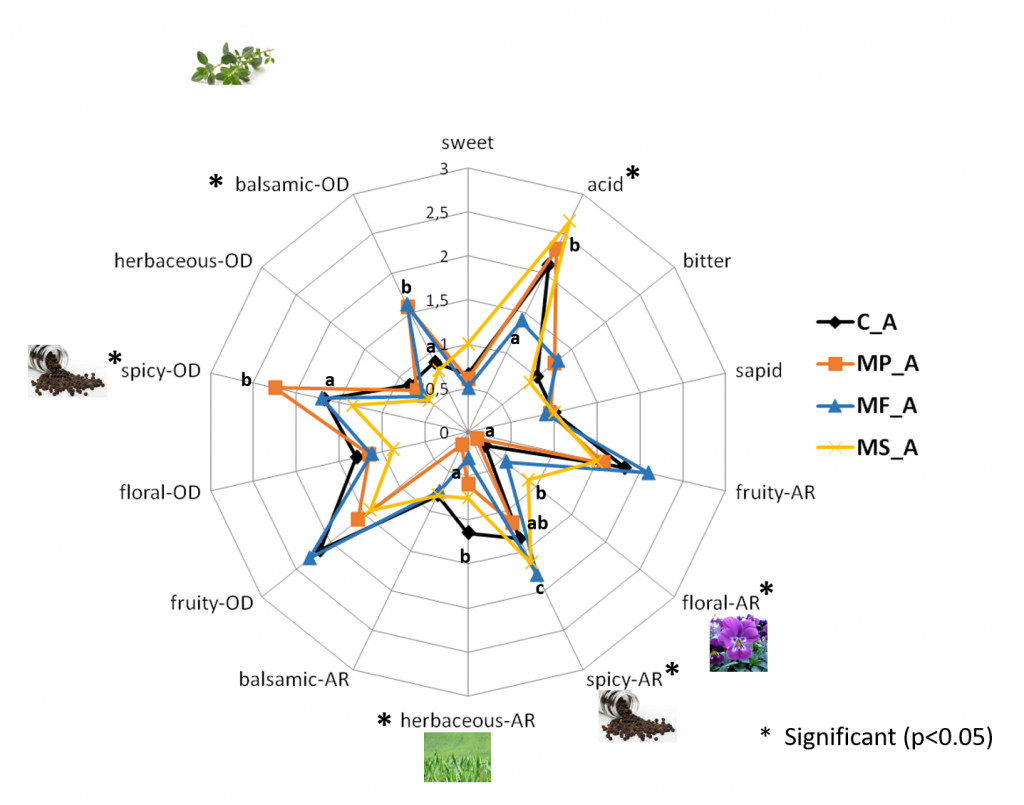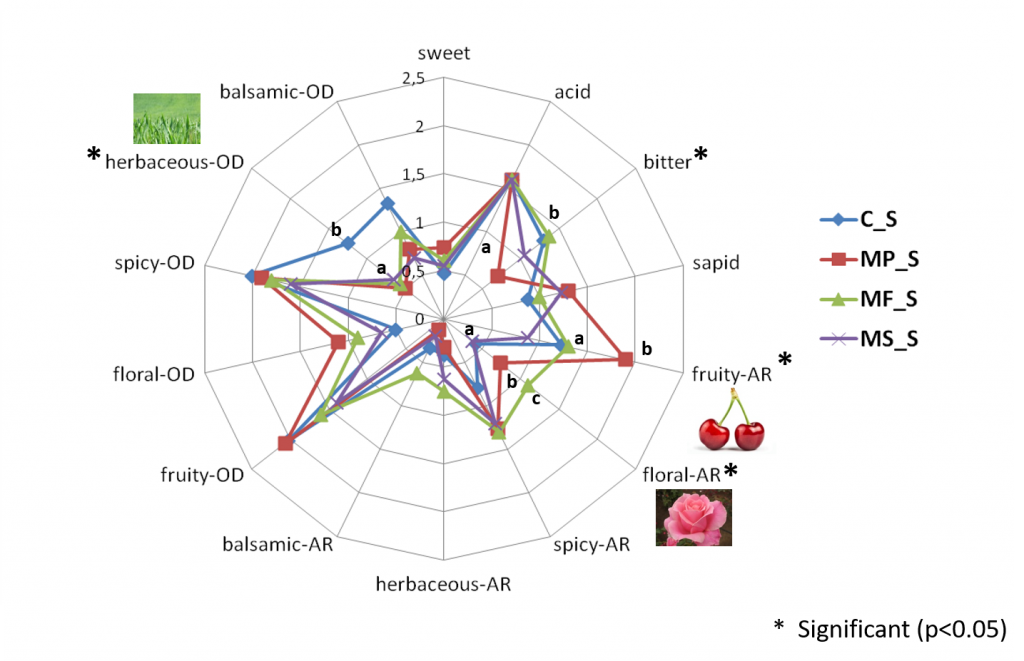By Alessandra Rinaldi
Mannoproteins (Mps) are naturally present in wine, because they are integral constituents of yeast cell wall. In winemaking conditions Mps are released by Saccharomyces cerevisiae during two phases of yeast cell cycle: 1) during alcoholic fermentation when cells are actively growing; and 2) during autolysis when cells are dying. The release of these compounds during wine aging on lees contributes to the organoleptic and physicochemical properties of wines. During the last years different commercial preparations based on yeast derivatives have been used in order to replace traditional ageing on lees, and actually are authorized by the International Organisation of Vine and Wine (Oeno 26/2004). Besides white wines, mannoproteins showed beneficial effects also on red wines, contributing to colour stability, to tasting improvements and flavor complexity (Pozo-Bayón, Andújar-Ortiz, & Moreno-Arribas, 2009). In this work, three commercial mannoproteins (MP; MF; MS) were tested in Aglianico and Sangiovese red wine during one year of aging to evaluate the influence on astringency characteristics (astringency intensity and 16 subqualities), and colour parameters (CIE L*a*b* coordinates, total anthocyanins, pigmented polymers) after 3, 6 and 12 months. The taste, odor and aroma profiles completed the sensory evaluation of one-year aged wines.
Aglianico wine is well known to be a wine rich in tannins, and highly astringent (Rinaldi, Iturmendi, Jourdes, Teissedre & Moio, 2015). Astringency intensity of Aglianico after 12 months, decreased in a significant way with MP treatment. A positive effect of Mps in reducing astringency was also previously stated (Rinaldi, Gambuti & Moio, 2012a), probably the interaction with phenolic compounds could prevent aggregation or precipitation of tannins. The qualitative aspect of astringency was evaluated by the use of the CATA question by a jury trained for astringency subqualities as previously reported (Rinaldi & Moio, 2018). Until now the effect of Mps on the subqualitative profile of astringency in red wines has never been studied.

In Figure 1, the correspondence analyses (CA) reveals that in tannin-rich wine as Aglianico the treatments with MP and MF were effective in reducing negative subqualities during aging (from 6 to 12 months), providing different sensory results. MP had an effect in removing the green and aggressive character of tannins making the wine silk, soft and full-bodied, while MF contributed to aroma complexity (rich and persistent) together with velvety and mouthcoating sensations.
In Sangiovese no differences in astringency were perceived after 12 months of aging. However, the effect of Mps was to reduce a strong astringency associated to sourness (green) and bitterness (hard), and to reach velvet, full-body, soft, rich and persistent sensations independently from the typology of Mps. The MF resulted the treatment that accelerated the achievement of such positive subqualities of astringency after 3 months of aging (Figure 2).

An aging period of 12 months with Mps affected the overall flavor profile of Aglianico depending on the commercial preparation used (Figure 3).

The effect of MF on taste was to reduce the sour sensation of Aglianico. This was in accordance with the proposed benefits of MF, a highly purified product with a high content of mannoproteins, that is to increase the perception of volume, roundness and length on the palate. In addition, the high protein content has been shown to be mainly related with an increase of flavor intensity, body balance and persistence (Ribeiro, Fernandes, Nunes, Filipe-Ribeiro & Cosme, 2014). All treatments in Aglianico significantly decreased the herbaceous aroma respect to control wine. The MS enhanced the floral aroma, mainly associated to violet (Cf > 20%), and together with MF enhanced the spicy one related to black pepper. As regard the odor, the black pepper was enhanced in MP treated wine while the balsamic notes increased both in MP and MF. As concern Sangiovese wine, the MP treatment was highly effective in decreasing the bitter perception, and increased the fruity aroma related to red cherry (Figure 4).

The floral aroma (rose) was significantly enhanced by MP and MF. Similarly, the presence of polysaccharides in wines had showed an effect on the intensities of the floral aroma attributes (Jones, Gawel, Francis & Waters, 2008). The herbaceous odor decreased by means of all Mps, indicating that a “fining effect” was obtained on these molecules negative for appreciation.
As regard colour, at the 6th month of Aglianico aging, the treatments with MS and MF promoted significant pigmented polymers (SPP+LPP) formation respect to control. However, no significant differences were denoted between samples after 1 year of aging. Probably the mannoproteins accelerated pigmented polymers formation by favoring multiple interactions with anthocyanins and flavanols which necessitates additional six months in untreated wines. The effect on the stabilization of the coloring matter by mannoproteins was recently observed, due to an increase in anthocyanin-derived pigments (A-type vitisins and F-A+ dimers) (Alcalde-Eon et al., 2014).
In Sangiovese wine the formation of pigmented polymers was enhanced in MS-6 and MF-6, and then at 12 months by all treatments. These Mps favored the formation of pigmented polymers with anthocyanins resistant to the action of SO2 as observed by others (Del Barrio-Galán, Pérez-Magariño, Ortega-Heras, Guadalupe, & Ayestarán, 2012), thus enhancing the colour stability of Sangiovese wine.
Results were in accordance with many studies on the beneficial effect of mannoproteins on astringency, sensory properties and colour stability. An improvement of the mouthfeel sensations was obtained depending on aging period and Mps typology. Commercial mannoproteins improved the sensorial characteristics related to body and persistence of wine, while not treated wines remained astringent, hard and characterized by green tannins. Finally, mannoproteins may have a positive effect on sensory perception of red wine, reducing astringency and bitterness, and encouraging aroma revelation and odor complexity. As regard the effect on colour, commercial preparations were mostly effective on Sangiovese wine, characterized by low colorant intensity and high hue values, promoting the pigmented polymer formation, and thus contributing to a better stability of wine colour during time.
Those interested in a longer length report can download the working paper at:
https://www.sciencedirect.com/science/article/pii/S0023643819301240

Alessandra Rinaldi
Alessandra Rinaldi actually is a researcher employed by Biolaffort, a research and development section of the enological society Laffort (Bordeaux, France) and detached at the University of Naples Federico II (Avellino, Italy). She received her master’s degree in Industrial Biotechnology from the University of Naples Federico II (2002) and attended the Laboratory of Enology of Bordeaux University directed by prof. Denis Dubordieu. She received the doctorat degree (funded by Biolaffort) in Science and Technology of Food-Agriculture Production from the University of Naples Federico II (2013) and attendend the Laboratory of Chemistry at ISVV (Bordeaux University) directed by prof. Pierre-Loius Teissedre. She has been working on yeast fermentation, on molecular microbiology, on wine technology, and on astringency sensation of red wines. During the last years she developped an analitical method to assess grape and wine astringency. She received a post-doctorat research bourse funded by Biolaffort on the enological potentiality of a protein extracted from potatoes for must and wine fining.
References:
- Alcalde-Eon, C., García-Estévez, I., Puente, V., Rivas-Gonzalo, J. C., & Escribano-Bailón, M. T. (2014). Color stabilization of red wines. A chemical and colloidal approach. Journal of Agricultural and Food Chemistry, 62(29), 6984-6994.
- Del Barrio-Galán, R., Pérez-Magariño, S., Ortega-Heras, M., Guadalupe, Z., & Ayestarán, B. (2012). Polysaccharide characterization of commercial dry yeast preparations and their effect on white and red wine composition. LWT-Food Science and Technology, 48(2), 215-223.
- Jones, P. R., Gawel, R., Francis, I. L., & Waters, E. J. (2008). The influence of interactions between major white wine components on the aroma, flavour and texture of model white wine. Food Quality and Preference, 19(6), 596-607.
- Pozo-Bayón, M. Á., Andújar-Ortiz, I., & Moreno-Arribas, M. V. (2009). Scientific evidences beyond the application of inactive dry yeast preparations in winemaking. Food Research International, 42(7), 754-761.
- Ribeiro, T., Fernandes, C., Nunes, F. M., Filipe-Ribeiro, L., & Cosme, F. (2014). Influence of the structural features of commercial mannoproteins in white wine protein stabilization and chemical and sensory properties. Food Chemistry, 159, 47-54.
- Rinaldi, A., & Moio, L. (2018). Effect of enological tannin addition on astringency subqualities and phenolic content of red wines. Journal of Sensory Studies, 33(3), e12325.
- Rinaldi, A., Gambuti, A., & Moio, L. (2012a). Precipitation of salivary proteins after the interaction with wine: the effect of ethanol, pH, fructose, and mannoproteins. Journal of Food Science, 77(4), C485-C490.
- Rinaldi, A., Iturmendi, N., Jourdes, M., Teissedre, P. L., & Moio, L. (2015). Transfer of tannin characteristics from grape skins or seeds to wine-like solutions and their impact on potential astringency. LWT-Food Science and Technology, 63(1), 667-676.

